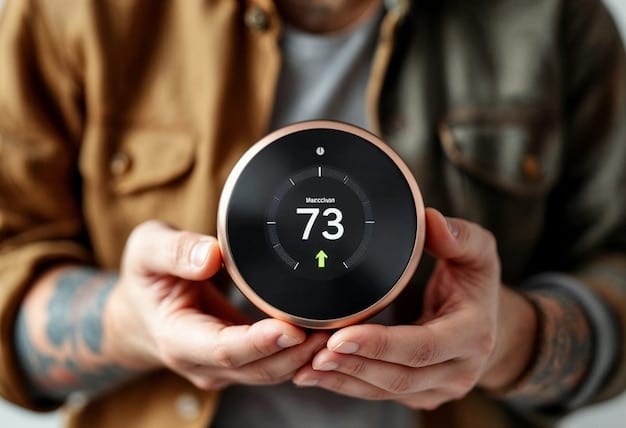Smart Thermostat Showdown: Top Energy Savings Brands in 2025

Embark on an insightful journey to discover which smart thermostat brands are poised to deliver the most substantial energy savings for homeowners in 2025, considering cutting-edge technology and user-friendly features.
Are you ready to optimize your home’s energy consumption and save money on utility bills? The Smart Thermostat Showdown: Which Brand Saves You the Most on Energy Bills in 2025? is here to help you navigate the world of smart thermostats and find the perfect fit for your needs.
Choosing the Right Smart Thermostat: An Overview
Smart thermostats have revolutionized the way we manage our home’s heating and cooling systems. By learning your habits and preferences, these devices can automatically adjust the temperature to maximize energy efficiency and minimize waste. But with so many brands and models on the market, choosing the right one can feel overwhelming.
This article will delve into the leading smart thermostat brands and evaluate their potential for delivering significant energy savings in 2025. We’ll consider factors like features, ease of use, compatibility, and pricing to help you make an informed decision.
Top Smart Thermostat Brands to Watch in 2025

Several brands have emerged as frontrunners in the smart thermostat market, each offering a unique blend of features and benefits. Let’s take a closer look at some of the top contenders:
Nest
Nest is arguably the most well-known smart thermostat brand, renowned for its sleek design and intuitive interface. The Nest Learning Thermostat is particularly popular for its ability to learn your schedule and automatically adjust the temperature accordingly.
Ecobee
Ecobee thermostats stand out for their smart room sensors, which allow you to monitor and control the temperature in individual rooms. This feature is particularly useful for homes with uneven heating or cooling.
Honeywell
Honeywell offers a range of smart thermostats, including the popular T9 and T10 Pro models. These thermostats are known for their compatibility with a wide range of HVAC systems and their advanced scheduling features.
- Nest Learning Thermostat: Known for its self-learning capabilities and elegant design.
- Ecobee SmartThermostat with voice control: Offers smart room sensors for targeted temperature control.
- Honeywell T9 Smart Thermostat: Compatible with various HVAC systems and features advanced scheduling options.
These are just a few of the many smart thermostat brands available. Each offering unique features and benefits that cater to a wide variety of user preferences and needs.
Evaluating Energy Saving Features
Beyond brand recognition, it’s crucial to assess the specific features that contribute to energy savings. Here are some key features to consider:
Learning Capabilities
Thermostats with learning algorithms can adapt to your habits and automatically optimize temperature settings. This feature eliminates the need for manual adjustments and ensures that your home is always at a comfortable temperature without wasting energy.
Geofencing
Geofencing uses your smartphone’s location to detect when you’re away from home and automatically adjust the thermostat to a more energy-efficient setting. This feature is particularly useful for those with irregular schedules.
Smart Room Sensors
Smart room sensors allow you to monitor the temperature in individual rooms and adjust the thermostat settings accordingly. This feature is ideal for homes with multiple zones or rooms that are not used frequently.
These features play a vital role in achieving optimal energy savings. By understanding how each feature functions and its potential impact on your energy consumption, you will be equipped to make a well-informed decision.

Cost Considerations and ROI
While the energy-saving benefits of smart thermostats are undeniable, it’s essential to consider the upfront cost and the potential return on investment (ROI). Here’s what you need to know:
Initial Investment
Smart thermostats typically range in price from $100 to $300, depending on the brand and features. Consider your budget and prioritize the features that are most important to you.
Installation Costs
While some smart thermostats are easy to install yourself, others may require professional installation. Factor in the cost of installation when calculating the overall ROI.
Long-Term Savings
The energy savings from a smart thermostat can vary depending on your usage patterns and local energy rates. However, most users can expect to save between 10% and 20% on their heating and cooling bills.
- Upfront Cost: Smart thermostats generally range from $100-$300 and up.
- Installation: DIY installation is possible for some models, while others might require professional assistance.
- Energy Savings: Expect to save about 10-20% on your energy bills.
Investing in a smart thermostat proves to be a worthwhile decision, especially considering the long-term savings and the increase in home comfort. By carefully assessing the costs and potential savings, you will be able to make a financially sound decision that aligns with your goals and preferences.
Smart Thermostat Compatibility and Ecosystem Integration
The compatibility of smart thermostats with other smart home devices and ecosystems is another crucial factor to consider. Here’s why:
Voice Assistant Integration
Many smart thermostats can be controlled via voice assistants like Amazon Alexa, Google Assistant, and Apple Siri. This integration allows you to adjust the temperature with simple voice commands.
Smart Home Platform Compatibility
Ensure that the smart thermostat you choose is compatible with your preferred smart home platform, such as SmartThings, Wink, or IFTTT. This will allow you to create custom automation routines and integrate your thermostat with other smart devices.
HVAC System Compatibility
Before purchasing a smart thermostat, verify that it’s compatible with your existing HVAC system. Some thermostats may not work with certain types of systems, such as those with millivolt wiring.
By carefully assessing the compatibility of the smart thermostat with other smart home devices and ecosystems, you will be able to create a fully integrated and automated smart home experience.
Looking Ahead: The Future of Smart Thermostats in 2025
As technology continues to evolve, we can expect even more advanced features and capabilities in smart thermostats. Here are some trends to watch for in 2025:
Enhanced AI and Machine Learning
Smart thermostats will become even better at learning your habits and preferences, using advanced AI and machine learning algorithms to optimize energy efficiency.
Predictive Maintenance
Some smart thermostats will be able to predict potential HVAC system problems and alert you before they become major issues.
Integration with Renewable Energy Sources
Smart thermostats will increasingly integrate with renewable energy sources like solar panels, allowing you to optimize energy consumption based on real-time energy production.
Keeping an eye on these trends will help ensure that you stay informed about the future of smart thermostats, enabling you to make informed and updated decisions. By understanding the potential advancements in technology, you will choose a thermostat that will continue to provide optimal efficiency and savings for years to come.
Making Your Decision: Factors to Consider
Choosing the right smart thermostat involves carefully weighing various factors to align with your unique needs and preferences. Before sealing the deal, consider these key points:
Energy Savings Goals
Assess your primary energy-saving goals and look for a thermostat that offers features that align with those objectives.
Budget
Establish a clear budget and explore options that offer the best value for your investment, balancing cost with the features you prioritize.
Smart Home Ecosystem
Ensure seamless integration with your existing smart home ecosystem to enhance convenience and overall smart home automation.
Ultimately, the perfect smart thermostat is the one that caters to your specific needs and requirements, offering the ideal combination of features, compatibility, and value. By engaging in this deliberation, you will be assured of selecting a thermostat that perfectly aligns with your preferences and provides optimal performance and enjoyment.
| Key Aspect | Brief Description |
|---|---|
| 💡 Energy Savings | Smart thermostats can save 10-20% on energy bills. |
| 🏡 Compatibility | Check compatibility with your HVAC system and smart home devices. |
| 💰 Cost & ROI | Consider the initial investment and long-term energy savings. |
| 🤖 Smart Features | Look for learning capabilities, geofencing, and room sensors. |
Frequently Asked Questions
▼
A smart thermostat is a Wi-Fi enabled thermostat that can automatically adjust temperature settings in your home for optimal comfort and energy efficiency.
▼
Most users can expect to save between 10% and 20% on their heating and cooling bills annually by utilizing a smart thermostat.
▼
Some smart thermostats are designed for easy DIY installation, while others are best installed by a professional HVAC technician.
▼
While many smart thermostats are designed to work with a wide range of HVAC systems. Be sure to confirm that the thermostat is compatible prior to buying.
▼
Yes, most smart thermostats can be controlled remotely via a smartphone app, allowing you to adjust settings from anywhere with an internet connection.
Conclusion
As we approach 2025, the smart thermostat market reveals a promising landscape of opportunities for homeowners aiming to enhance energy efficiency and reduce utility costs. By considering the factors outlined in this guide, you can confidently navigate the options and select a smart thermostat that aligns with your needs, preferences, and budget. Embracing smart technology not only streamlines your home environment but also contributes to a more sustainable future.





